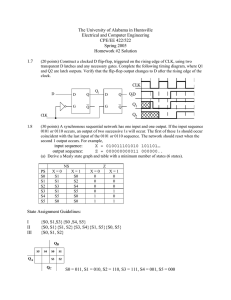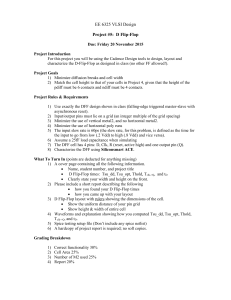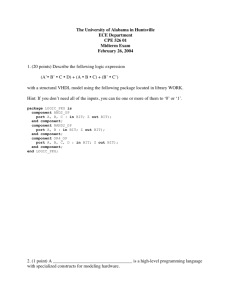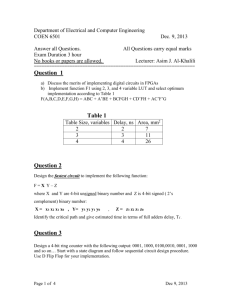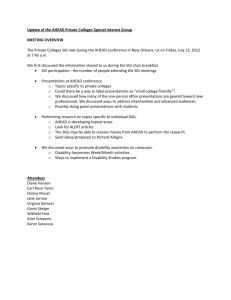The University of Alabama in Huntsville ECE Department CPE/EE
advertisement
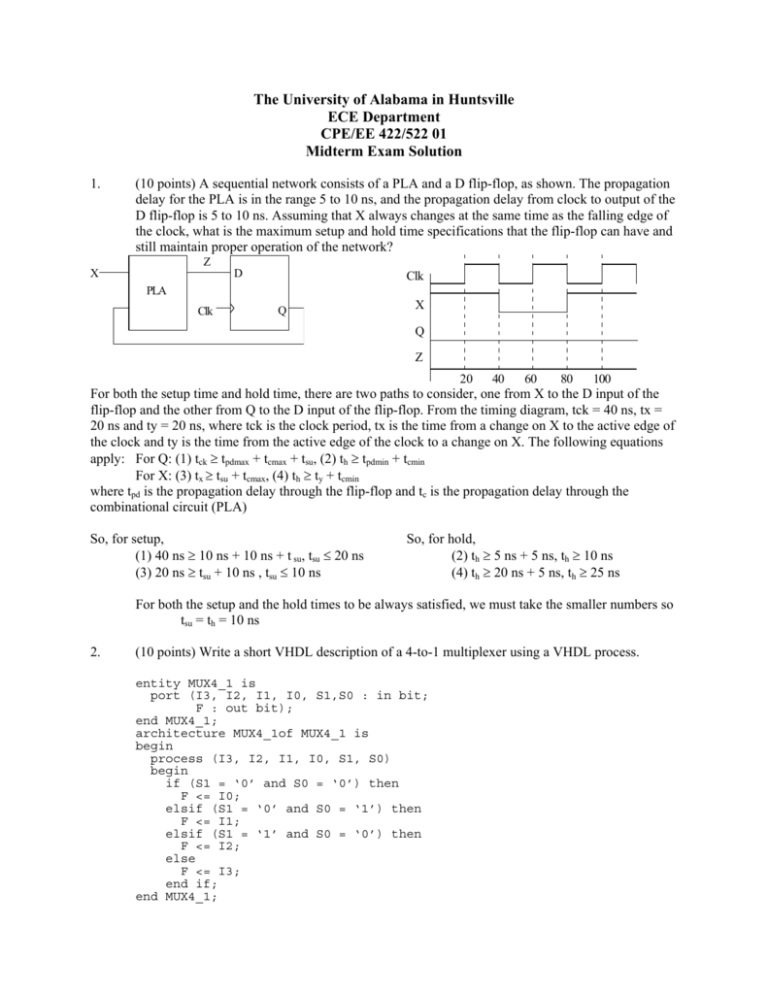
The University of Alabama in Huntsville ECE Department CPE/EE 422/522 01 Midterm Exam Solution 1. (10 points) A sequential network consists of a PLA and a D flip-flop, as shown. The propagation delay for the PLA is in the range 5 to 10 ns, and the propagation delay from clock to output of the D flip-flop is 5 to 10 ns. Assuming that X always changes at the same time as the falling edge of the clock, what is the maximum setup and hold time specifications that the flip-flop can have and still maintain proper operation of the network? Z X D Clk PLA Clk Q X Q Z 20 40 60 80 100 For both the setup time and hold time, there are two paths to consider, one from X to the D input of the flip-flop and the other from Q to the D input of the flip-flop. From the timing diagram, tck = 40 ns, tx = 20 ns and ty = 20 ns, where tck is the clock period, tx is the time from a change on X to the active edge of the clock and ty is the time from the active edge of the clock to a change on X. The following equations apply: For Q: (1) tck ≥ tpdmax + tcmax + tsu, (2) th ≥ tpdmin + tcmin For X: (3) tx ≥ tsu + tcmax, (4) th ≥ ty + tcmin where tpd is the propagation delay through the flip-flop and tc is the propagation delay through the combinational circuit (PLA) So, for setup, (1) 40 ns ≥ 10 ns + 10 ns + t su, tsu ≤ 20 ns (3) 20 ns ≥ tsu + 10 ns , tsu ≤ 10 ns So, for hold, (2) th ≥ 5 ns + 5 ns, th ≥ 10 ns (4) th ≥ 20 ns + 5 ns, th ≥ 25 ns For both the setup and the hold times to be always satisfied, we must take the smaller numbers so tsu = th = 10 ns 2. (10 points) Write a short VHDL description of a 4-to-1 multiplexer using a VHDL process. entity MUX4_1 is port (I3, I2, I1, I0, S1,S0 : in bit; F : out bit); end MUX4_1; architecture MUX4_1of MUX4_1 is begin process (I3, I2, I1, I0, S1, S0) begin if (S1 = ‘0’ and S0 = ‘0’) then F <= I0; elsif (S1 = ‘0’ and S0 = ‘1’) then F <= I1; elsif (S1 = ‘1’ and S0 = ‘0’) then F <= I2; else F <= I3; end if; end MUX4_1; 3. (15 points) For the following VHDL, assume that A changes to ‘1’ at 5 ns. Give the values of A, B, C, D, E, and F each time a change occurs. Carry this out until no further change occurs. I entity prob is port (D : inout bit); end prob; Time 0 ns 5 ns 6 ns 8 ns 15 ns 20 ns 24 ns architecture PROB of PROB is signal A, B, C, E, F : bit; begin P1: process (A, C) begin B <= A after 3 ns; E <= C after 5 ns; end process P1; C1: C <= A after 10 ns; P2: process (C, E) begin F <= C and E after 4 ns; end process P2; C2: D <= A or B or C or F after 1 ns; end PROB; Time Event 5 ns A → ‘1’ Process Triggered P1 P1 C1 C2 none C2 P1 P1 P2 C2 P2 C2 6 ns D → ‘1’ 8 ns B → ‘1’ 15 ns C → ‘1’ 20 ns E → ‘1’ 24 ns F → ‘1’ 4. A B 0 0 1 0 1 0 1 1 1 1 1 1 1 1 C D E 0 0 0 0 0 0 0 0 0 0 1 0 1 1 0 1 1 1 1 1 1 Scheduled Transaction B ‘1’ 8 ns E ‘0’ 10 ns C ‘1’ 15 ns D ‘1’ 6 ns Event? Yes No Yes Yes D ‘1’ 9 ns B ‘1’ 18 ns E ‘1’ 20 ns F ‘0’ 19 ns D ‘1’ 16 ns F ‘1’ 24 ns D ‘1’ 25 ns No No Yes No No Yes No (5 points) Obtain a minimum product of sums expression for the following function: f(A, B, C, D) = ΠM(0, 1, 2, 4, 5, 8, 9, 10) f’ = (B’C’ + A’C’ + B’D’)’ = (B’C’)’(A’C’)’(B’D’) = (B + C)(A + C)(B + D) C 0 0 1 0 0 0 1 1 1 1 1 1 0 0 1 0 B A D F 0 0 0 0 0 0 1 5. (15 points) A Mealy sequence detector detects a sequence of four consecutive 1 inputs. The detector has a single binary input, X, and a single binary output, Z. Signal Z should be logic 1 if and only if the last four inputs were all logic 1. Here is an example input-output sequence: X Z 010111111101101011110 000000111100000000010 Derive a Mealy state graph and table with a minimum number of states for this sequence detector Next State Output Present State X = 0 X = 1 X = 0 X = 1 S0 S0 S1 0 0 S1 S0 S2 0 0 S2 S0 S3 0 0 S3 S0 S3 0 1 0/0 S0 1/0 0/0 S1 1/0 0/0 S2 1/0 0/0 6. S3 1/1 (10 points) For the following Ft, find all static-1 hazards. For each hazard, specify the values of the input variables and which variable is changing when the hazard occurs. Ft = ab’ + ac’ + bb’ + bc’ + a’d’ 1 2 c 1 0 0 1 1 1 0 1 1 1 0 0 1 1 1 1 For hazard 1, a is changing and bcd = 000 For hazard 2, a is changing and bcd = 010 b a d 7. (10 points) Reduce the following state table to a minimum number of states. Show all your work in determining the state equivalents Next State Present State X = 0 X = 1 Output A I C 1 B B I 1 C C G 1 D I C 0 E D E 0 F I C 0 G E F 0 H H A 1 I A C 1 Next State Present State X = 0 X = 1 Output A A C 1 B B A 1 C C G 1 D A C 0 E D E 0 G E D 0 B I=B C=I C I=C C=G I=G D B I=B C=I C I=C I=G C=G D I=D C=E E D=E I=C F I=H C=A I=A A=G E=H F=A I A=B A=C I=A C=I C=G E=A F=C H=A A=C G H B I=B C=I C I=C C=G C D E F I=E C=F G H B D=E I=C F I=E C=F G A I=D C=E E H I=H C=A I=A A=G E=H F=A I A=B A=C I=A C=I C=G E=A F=C H=A A=C G H A B I=G D I=D C=E E D=E I=C F I=E C=F G H I I=H I=A A=G C=A E=H F=A A=B A=C C=I C=G E=A F=C H=A A=C G H I=A A 8. B C D E F (5 points) Write out the truth table for the following equation. F = (A • B’) + C A B C F 0 0 0 0 0 0 1 1 0 1 0 0 0 1 1 1 1 0 0 1 1 0 1 1 1 1 0 0 1 1 1 1 C D E F 9. (5 points) Draw a timing diagram that illustrates the difference between a D flip-flop and a D latch. D QF CLK D QL CLK/G D CLK QF QL 10. (1 point) __Synchronous_ design is a technique that uses a clock to coordinate the operation of all flip-flops, registers and counters in the system. 11. (1 point) The value of a ___variable__ changes instantaneously in VHDL 12. (1 point) A process with a sensitivity list is activated whenever _an event occurs on any signal_ __in the sensitivity list_. 13. (1 point) VHDL is case-sensitive (True/False) __False_ 14. (1 point) __Sequential__ networks commonly use flip-flips as storage devices. 15. (10 points) Draw the state diagram for the following state machine. Is it a Moore machine or a Mealy machine? ENTITY state_machine IS PORT (sig_in ; IN BIT; clk : IN BIT; sig_out : OUT BIT); END state_machine; ARCHITECTURE state_machine OF state_machine IS TYPE state_type IS (a, b, c, d, e); SIGNAL current_state, next_state : state_type; BEGIN PROCESS (sig_in, current_state) BEGIN sig_out <= ‘0’; next_state <= b; CASE current_state WHEN a => IF sig_in = ‘0’ THEN next_state <= e; sig_out <= ‘1’; ELSE next_state <= d; END IF; WHEN b => IF sig_in = ‘0’ THEN next_state <= b; ELSE next_state <= d; sig_out <= ‘1’; END IF; WHEN c => IF sig_in = ‘1’ THEN next_state <= a; ELSE next_state <= d; END IF; WHEN d => IF sig_in = ‘0’ THEN next_state <= e; END IF; WHEN e => IF sig_in = ‘1’ THEN next_state <= a; END IF; END CASE; END PROCESS; PROCESS (clk) BEGIN IF (clk’EVENT AND clk = ‘1’) THEN current_state <= next_state; END IF; END PROCESS; END state_machine; Mealy 1/0 c 1/0 a 0/1 0/0 1/0 0/0 d 1/0 1/1 e 0/0 b 0/0 Extra Credit (5 points): Rework problem 6 using a Moore machine. 0 Next State Present State X = 0 X = 1 Output S0 S0 S1 0 S1 S0 S2 0 S2 S0 S3 0 S3 S0 S4 0 S4 S0 S4 1 S0 0 1 0 S1 0 0 S2 0 1 1 0 S3 0 1 0 S4 1 1
